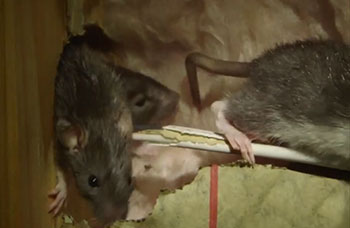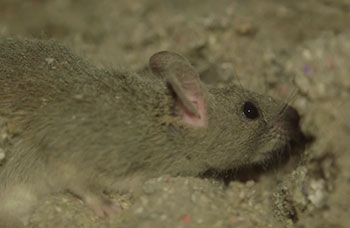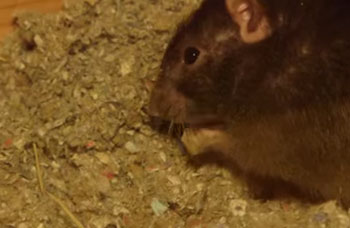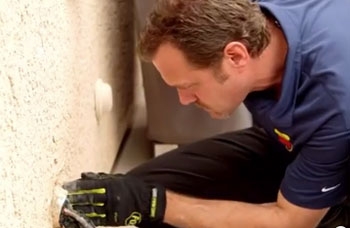Rat Types & Facts
Roof Rat Facts
- 10-12 inches in length and can be either black, brown or gray in color.
- Also known as the ship rat or black rat and are usually found in coastal areas.
- Adults can weigh between 5-9 ounces and spread diseases through their urine and droppings.
Rat Photos
-
 Pack rat.
Pack rat. -
 Pack rat.
Pack rat. - View More Photos
Roof Rats
One of the most common rat species in the United States, Roof rats, also known as black rats, are generally smaller, sleeker, and slightly slimmer than Norway rats. The roof rat has a more limited geographical range than the Norway rat, preferring ocean-influenced, warmer climates. They are found primarily in the southeastern states and western coastal regions of the United States.
What Are Roof Rats?
Roof rats typically weigh 5 to 9 ounces. They have light black to grey smooth fur on their bodies with off white to grey underbellies. They can be over 16 inches long, and have a long hairless tail that can be about 14-1/2 inches long. Unlike Norway rats, their tails are longer than their heads and bodies combined. They have large ears and eyes (typically larger than those of the Norway rat) and have a pointed nose.
As their name indicates, roof rats usually nest high above ground in trees, tall overgrown shrubs, or dense vegetation such as ivy. Roof rats are excellent climbers and often access homes by running along tree branches, cables or wires. In buildings, they typically nest in the upper part of structures in enclosed or elevated spaces such as attics, walls, false ceilings, and cabinets. They are very agile and can squeeze through openings only 1/2-inch wide. Roof rats can climb down to a food source.
Roof rats routinely travel up to 300 feet for food. They often can be seen at night running along overhead utility lines or fence tops. They have an excellent sense of balance and use their long tails to steady themselves while traveling along overhead utility lines. They move faster than Norway rats and are very agile climbers, which enables them to quickly escape predators.
Roof Rat Infestation
As climbers, roof rats are more likely to cause structural damage in homes as they chew on wood and wires. Like Norway rats, roof rats eat a wide variety of foods, but they prefer fruits, nuts, berries, slugs, and snails. Roof rats are especially fond of avocados and citrus, and they often eat fruit that is still on the tree. If roof rats are living in the attic of a residence, they can cause considerable damage with their gnawing and nest-building activities. Roof rats prefer to nest in locations off the ground and rarely dig burrows for living quarters if off-the-ground sites exist.
If roof rats are seen exposed, it often indicates that their hiding spaces are all filled by other rats or that they have been disturbed, such as by construction. Droppings are another good indicator of roof rat activity. Roof rat droppings are 4-1/2 to 5 inches with pointed ends (whereas Norway rat droppings are 7 to 7-1/2 inches) and capsule shaped. Other indicators can include grease marks which are produced as the rodent travels along an edge, and the oils in their fur are deposited. Indoor nests usually are constructed in insulation such as in attics.
How to Get Rid of Roof Rats
To prevent a roof rat colony from nesting in your home, make sure that all the windows and vents are screened. Roof rats can also enter openings in walls, eaves and roof from the branches of trees. Trim all tree branches to further prevent entry.
As its name indicates, these species of rats are most likely to be found in higher places and upper levels of the home. Thus traps should be placed off the ground in the attic, rafters of the garage, on shelves and ledges. Rats are typically suspicious of new things in their environment and will avoid traps unless there is something very attractive on the trap. Roof rats may be attracted to simple food scraps including pieces of fruit and bacon. In addition, try putting the attractant out for a few days before setting the trap. This will get the rat used to eating at that location.
Toxic baits or rodenticides are intended to kill the rats when they eat the bait. Rodenticides are potentially harmful to non-targets such as people or pets if not applied correctly. It is advisable to first consult a pest control professional.
Roof Rat Bites & Treatment
In general, Rats can spread disease through biting or contact with their fecal matter, or droppings. Don’t approach a wild rat – generally, they’re more afraid of you than you are from them. Rats will bite or scratch if frightened or handled, so leave them alone. Roof rats have long been named as carriers of the fleas responsible for the plague (also known as the Black Death) in the Middle Ages. While this plague is no longer as serious a threat to humans, roof rats are still potential carriers of disease.
Rat bites may be contaminated with Streptobacillus moniliformis or Spirillum minus. S. moniliformis is most common in the US. These infections may lead to Rat Bite Fever. Symptoms of Rat Bite Fever may appear as much as 10 days after the bite, and are likely to happen after the wound itself is already healed. Watch for fever, headache, vomiting, and pain in the back and joints. Two to 4 days after the onset of fever, a rash may occur on the hands and feet, and one or more large joints may become swollen, red, and painful. If the victim exhibits any of these symptoms, see a doctor immediately.



